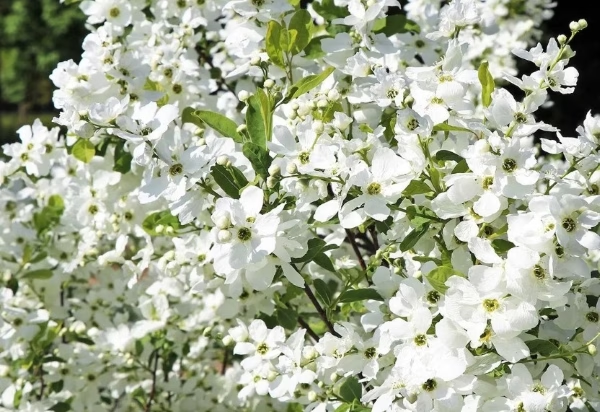
Pearl Bush
Botanical Name
:
Exochorda racemosa
Plant Type
:
Deciduous flowering shrub
Seasons
:
Plant in early spring or fall; Blooms in late spring
Sun Level
:
Full sun to partial shade; prefers at least 6 hours of sunlight but tolerates some shade
Ideal Soil Temperature for Planting
:
60–70°F (15–21°C); but it can tolerate a wider range of temperatures once grown
Soil Type
:
Well-drained, loamy soil; adapts to sandy or clay soils
Hardiness Zones
:
4–8 (USDA)
Germination
:
Seeds can take several months to germinate due to dormancy; propagation is mostly done by softwood cuttings
P.H. Level
:
Neutral to slightly acidic (6.0–7.5)
Water/Irrigation
:
Moderate water needs; keep soil evenly moist but not waterlogged
Fertilization
:
Apply a balanced fertilizer with an NPK ratio around 10-10-10 in early spring
Habit
:
Arching, irregular, multi-stemmed, upright; forms a rounded, bushy shape
Propagation
:
Softwood cuttings, seeds
Final Plant Height
:
10–15 ft
Spread
:
10–15 ft
Flowers
:
Pure white, five-petaled blooms; buds resemble pearls before opening
Attracts
:
Bees, butterflies, and other pollinators
Uses
:
Specimen planting, shrub borders, mixed hedges
Companions
:
Lilacs, spireas, hydrangeas, and flowering dogwoods
Pruning
:
Prune immediately after flowering to shape the plant and encourage new growth
Toxicity
:
Non-toxic to humans and pets
Pests
:
Generally pest-free; occasional issues with aphids or scale insects
Diseases
:
Rarely affected by diseases; possible powdery mildew in high humidity
Fun Fact
:
The Pearl Bush gets its name from the pearl-like appearance of its buds, which line the branches and resemble a string of pearls before bursting into bloom
Additional Info
:
Since it blooms on the previous year’s growth, it’s best to wait until the current flowers have faded before pruning, using them as a guide for how much to trim.
Botanical Name
:
Exochorda racemosa
Plant Type
:
Deciduous flowering shrub
Seasons
:
Plant in early spring or fall; Blooms in late spring
Sun Level
:
Full sun to partial shade; prefers at least 6 hours of sunlight but tolerates some shade
Ideal Soil Temperature for Planting
:
60–70°F (15–21°C); but it can tolerate a wider range of temperatures once grown
Soil Type
:
Well-drained, loamy soil; adapts to sandy or clay soils
Hardiness Zones
:
4–8 (USDA)
Germination
:
Seeds can take several months to germinate due to dormancy; propagation is mostly done by softwood cuttings
P.H. Level
:
Neutral to slightly acidic (6.0–7.5)
Water/Irrigation
:
Moderate water needs; keep soil evenly moist but not waterlogged
Fertilization
:
Apply a balanced fertilizer with an NPK ratio around 10-10-10 in early spring
Habit
:
Arching, irregular, multi-stemmed, upright; forms a rounded, bushy shape
Propagation
:
Softwood cuttings, seeds
Final Plant Height
:
10–15 ft
Spread
:
10–15 ft
Flowers
:
Pure white, five-petaled blooms; buds resemble pearls before opening
Attracts
:
Bees, butterflies, and other pollinators
Uses
:
Specimen planting, shrub borders, mixed hedges
Companions
:
Lilacs, spireas, hydrangeas, and flowering dogwoods
Pruning
:
Prune immediately after flowering to shape the plant and encourage new growth
Toxicity
:
Non-toxic to humans and pets
Pests
:
Generally pest-free; occasional issues with aphids or scale insects
Diseases
:
Rarely affected by diseases; possible powdery mildew in high humidity
Fun Fact
:
The Pearl Bush gets its name from the pearl-like appearance of its buds, which line the branches and resemble a string of pearls before bursting into bloom
Additional Info
:
Since it blooms on the previous year’s growth, it’s best to wait until the current flowers have faded before pruning, using them as a guide for how much to trim.
Written by Nondiah Khalayi – https://www.linkedin.com/in/nondiah-khalayi/

